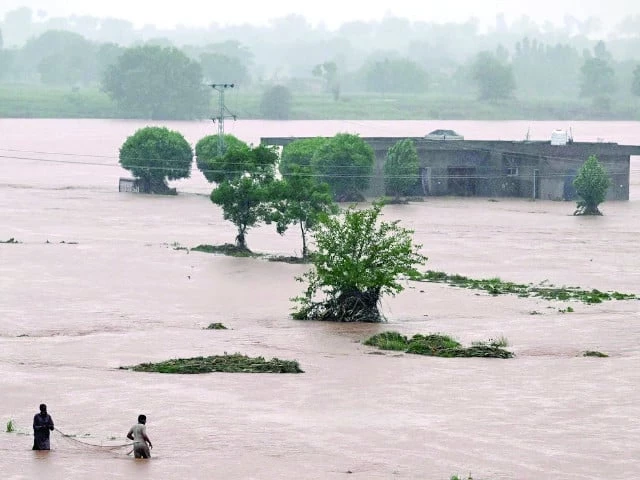KARACHI:
Pakistan’s central financial institution is predicted to maintain its key price regular on Monday, a Reuters ballot confirmed, as floods that ravaged farmland and threaten recent meals inflation immediate policymakers to increase their pause on financial easing.
13 of 14 analysts surveyed forecast the State Financial institution of Pakistan (SBP) will maintain its coverage price at 11%, whereas one projected a 50 basis-point reduce.
Since late June, floods have swamped Punjab’s farmland, disrupting provide chains and stoking inflation fears, with almost 950 individuals killed, 6,500 livestock misplaced, 8,200 homes destroyed and 4.5 million displaced as waters transfer south.
“Given the uncertainty, we anticipate the central financial institution might pause in September, although our base case permits for a 50100 bps reduce by year-end,” stated Waqas Ghani, Head of Analysis at JS World Capital.
Analysts flag GDP hit, meals value shocks
Sana Tawfik, Head of Analysis at Arif Habib Restricted, stated agricultural losses may shave round 0.2% off gross home product (GDP) development, although reconstruction might present some offset.
Analysts stated flood-driven provide shocks, particularly in wheat, rice and greens, may maintain inflation above the central financial institution’s 57% goal.
Saad Hanif of Ismail Iqbal Securities stated meals inflation may face “non permanent shocks”, with wheat costs up about 50% in a month.
Inflation eased to three% in August from 4.1% in July, however the finance ministry, which projected 4% to five%, warned crop losses and excessive climate may quickly push costs greater.
“Producers have additionally raised promoting costs, citing greater gas and transport prices and delays in enter deliveries brought on by flooding,” stated Ahmad Mobeen, Senior Economist at S&P World Market Intelligence.
The SBP has reduce charges by 1,100 foundation factors since June 2024, once they stood at a report 22% after inflation peaked close to 40% in 2023. It final reduce charges by 100 bps in Could, after a March pause, and held regular in June amid oil value pressures from Center East tensions.
Nonetheless, some see room for cuts
“Actual rates of interest are nonetheless excessive sufficient to permit for a reduce, particularly with the Fed turning dovish, however the floods are inflationary, significantly for meals,” stated Ammar Habib, an impartial analyst.
ADB warns to insure towards floods
In the meantime, an Asian Improvement Financial institution (ADB) skilled urged Pakistan, and different nations in Asia and the Pacific, to combine insurance coverage into city planning to restrict flood losses and velocity restoration.
Arup Kumar Chatterjee, Principal Monetary Sector Specialist at ADB, stated on Friday that cities like Lahore in Pakistan and Gurugram, India, face extreme flooding dangers however stay financially uncovered resulting from poor planning. Streets flip into rivers and houses into ruins, leaving cities in monetary peril. “These points aren’t random; they’re the results of poor planning,” he famous.
“In 2023, pure hazards in Asia and the Pacific induced $65 billion in losses, with 91% of that quantity uninsured. In 2024, international insured losses reached $135 billion, exhibiting an enormous safety hole of almost 90%,” wrote Chatterjee.
The ADB official identified that historical cities managed dangers higher. Mohenjo-Daro in Pakistan and the aqueducts in Rome have been designed to resist floods.
“Right now’s method to catastrophe administration has modified. Governments typically focus extra on post-disaster aid than on flood prevention. This typically results in completely different authorities departments working in isolation and ignoring danger administration,” he stated.
The price of neglecting insurance coverage is evident. He identified that Bangkok’s 2011 floods induced $47 billion in harm, with solely a 3rd insured. Chennai’s 2015 floods introduced $3.5 billion in losses, with simply 34% coated. Current storms in Dubai additionally uncovered main gaps.
In distinction, cities that undertake insurance coverage fare higher. Throughout Valencia’s 2024 floods, a 3rd of $10 billion in damages was insured. Auckland’s 2023 floods had 40% protection, permitting 112,000 claims to be processed rapidly.
“Now we have the instruments to handle flood dangers higher, together with satellite tv for pc expertise and real-time information evaluation. If we are able to predict floods, we also needs to be capable of finance safety prematurely,” pressured Chatterjee.
He urged that insurance coverage be handled as infrastructure. Fast payouts based mostly on rainfall information may help communities recuperate quicker. He urged Pakistan and different governments to make protection accessible, together with for renters and low-income households.
“No main challenge ought to proceed and not using a danger financing plan,” he stated, including that, “Floods are inevitable; the query is whether or not we are able to reply rapidly sufficient to stop despair. Each uninsured challenge is a danger to taxpayers, costing them in each cash and stress. Cities have to embrace insurance coverage as a foundational factor of their planning, not as an afterthought.”
The price of being unprepared, he warned, far outweighs the price of insurance coverage.
REUTERS WITH ADDITIONAL INPUT FROM OUR CORRESPONDENT

